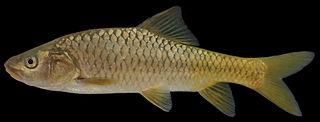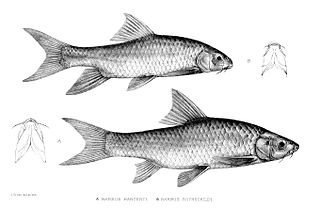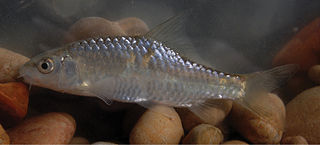
A barb is one of various ray-finned fish species in a non-phylogenetic group, with members in the family Cyprinidae, and especially the genera Barbus and Puntius, but many others also. They were formerly united with the barbels in the subfamily Barbinae but that group is paraphyletic with the Cyprininae. If the Labeoninae are recognized as distinct, many small African "barbs" would probably, however, warrant recognition as a new subfamily.

The Jordan himri is a ray-finned fish species in the family Cyprinidae.

Carasobarbus fritschii is a species of ray-finned fish in the family Cyprinidae. It is found only in the upper parts of the rivers of Morocco. Its natural habitat is rivers.

Carasobarbus harterti is a ray-finned fish species in the family Cyprinidae. It is found only in Morocco.
Carasobarbus moulouyensis is a ray-finned fish species in the family Cyprinidae. It is found only in Morocco.
Barbus paytonii is a doubtfully distinct ray-finned fish species in the family Cyprinidae. It is found only in Morocco.

Carasobarbus, the himris, is a small genus of ray-finned fishes in the family Cyprinidae. Its species are found in rivers, streams, lakes and ponds in Western Asia and Northwest Africa. C. canis can reach 66 cm (26 in) in total length, but most other species are up to around half or one-quarter of that size.

Labeobarbus is a mid-sized ray-finned fish genus in the family Cyprinidae. Its species are widely distributed throughout eastern Africa and especially southern Africa, but also in Lake Tana in Ethiopia. A common name, in particular for the southern species, is yellowfish. The scientific name refers to the fact that these large barbs remind of the fairly closely related "carps" in the genus Labeo in size and shape. As far as can be told, all Labeobarbus species are hexaploid.
Luciobarbus is a genus of ray-finned fishes in the family Cyprinidae. Its members are found in fresh and brackish waters of southern Europe, northern Africa, the wider Near East, the Aral and Caspian Seas, and rivers associated with these. Several species in the genus are threatened. Most species are fairly small to medium-sized cyprinids, but the genus also includes several members that can surpass 1 m (3.3 ft) in length and the largest, the mangar can reach 2.3 m (7.5 ft).
Barbinae are a subfamily of fish included in the family Cyprinidae. The taxonomy for this group has not been entirely worked out as some genera historically considered within it are still considered incertae sedis with respect to being a member of the family, and may be included here, while others may be moved to other subfamilies.

Capoeta damascina, the Levantine scraper or Mesopotamian barb, is a species of cyprinid fish from the Near East region. It is reported from Iraq, Israel, Jordan, Lebanon, Syria, Iran and Turkey.
Capoeta kosswigi, also known as the Van scraper or Van barb, is a species of cyprinid fish living in Turkey, in the Van Lake basin. It is however likely that this is the same fish as Capoeta damascina, and the name is thus just a synonym.

The Mesopotamian himri is a species of ray-finned fish in the genus Carasobarbus.

The Arabian himri is a species of ray-finned fish in the genus Carasobarbus. It is endemic to Saudi Arabia in wadis in the Hijaz Mountains which either drain into the Red Sea or inland.

Carasobarbus sublimus is a species of ray-finned fish in the genus Carasobarbus. It is endemic to the River Tigris in Iraq.
Oxynoemacheilus kosswigi, the Paphlagonian loach, is a species of ray-finned fish in the genus Oxynoemacheilus. This species is found in the Kizilirmak and Yeşilırmak drainages in northern Anatolia, Turkey. It lives in waters which vary from those with a moderately fast flow to almost still waters and prefers muddy or gravel substrates, It remains abundant and widespread within the two drainage systems in which it occurs but it is suspected that a number f populations may have declined or been made locally extinct by the increasing construction of small hydro-electric dams.

Turcinoemacheilus kosswigi is a species of stone loach which is endemic to the Tigris-Euphrates Basin where it can be found in the stretches of rivers, eve small streams, with faster currents and it often occurs on riffles and rapids. The specific name honours the zoologist and geneticist Curt Kosswig (1903-1982), who collected the type specimen of this species among others he collected in Turkey.
Kosswig's barbel is a species of ray-finned fish in the genus Luciobarbus. It is found in the Tigris watershed in Turkey.
Squalius kosswigi is a species of ray-finned fish in the family Cyprinidae. It is endemic to the Tahtali River in Turkey.











